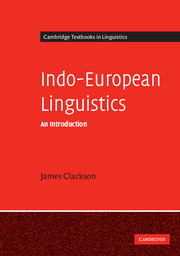Book contents
- Frontmatter
- Contents
- List of figures
- List of tables
- Preface
- Transliteration conventions
- 1 The Indo-European language family
- 2 Phonology
- 3 Morphophonology
- 4 Nominal morphology
- 5 Verbal morphology
- 6 Syntax
- 7 Lexicon and lexical semantics
- Glossary
- References
- Word index
- Language index
- Person index
- Subject index
3 - Morphophonology
Published online by Cambridge University Press: 05 June 2012
- Frontmatter
- Contents
- List of figures
- List of tables
- Preface
- Transliteration conventions
- 1 The Indo-European language family
- 2 Phonology
- 3 Morphophonology
- 4 Nominal morphology
- 5 Verbal morphology
- 6 Syntax
- 7 Lexicon and lexical semantics
- Glossary
- References
- Word index
- Language index
- Person index
- Subject index
Summary
Introduction
This chapter deals broadly with issues that lie on the interface between phonology and morphology in reconstructed PIE. We first consider the phonological shape of reconstructed morphemes, before proceeding to discuss a process of vowel alternation known as ablaut. Ablaut is fundamental to much of PIE morphology, and this chapter consequently contains much that anticipates some of the reconstruction of morphological paradigms in following chapters. Current hypotheses to explain the origin and mechanics of ablaut in PIE relate it to the nature and location of the word-accent, and consequently we have also included in this chapter a section on the reconstruction of the PIE accent. We have titled this chapter morphophonology partly in the tradition of Trubetzkoy, who first proposed a separable sub-discipline covering the uses of a language's phonological resources in morphology, and partly as an indication of the historical uncertainty about how to describe ablaut, whether in phonological or morphological terms.
Morpheme structure constraints
The comparison of cognate forms in IE languages leads not only to the reconstruction of lexical items and phonemes, but also to lexical bases traditionally termed roots. The process of abstracting a root from the comparative reconstruction of PIE word-forms can be exemplified by the root *yug- ‘join’.
- Type
- Chapter
- Information
- Indo-European LinguisticsAn Introduction, pp. 64 - 89Publisher: Cambridge University PressPrint publication year: 2007



